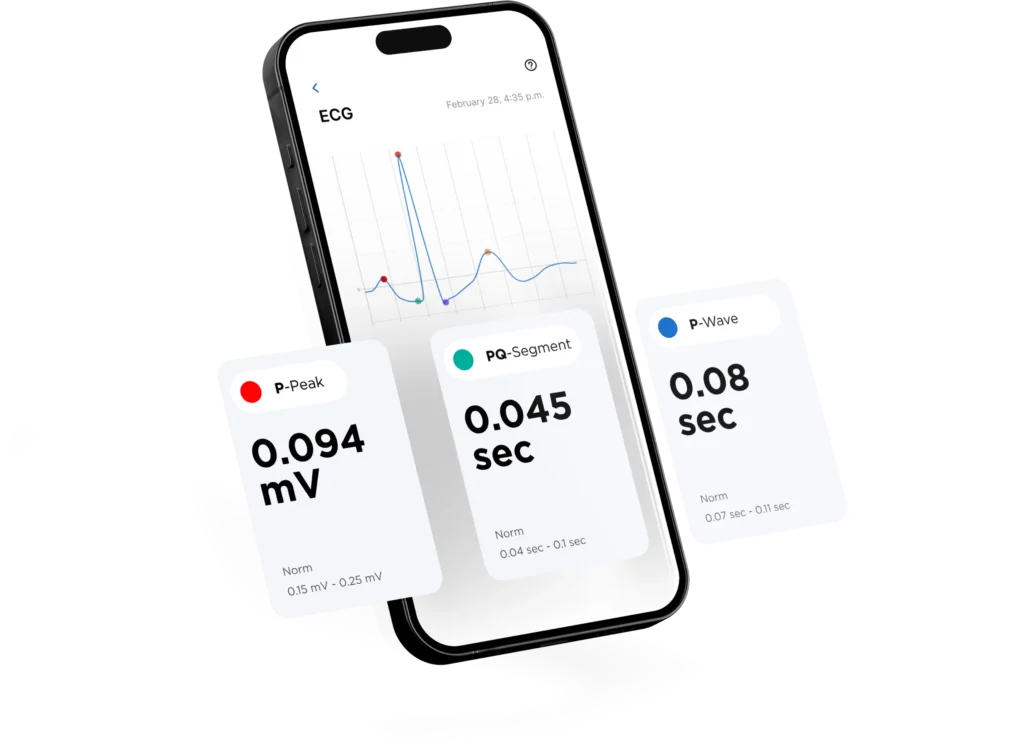
Take a photo of your ECG printout and get clear answers about your heart rhythm in seconds
ECG printouts contain complex waveform patterns that are difficult to understand without medical training. During moments of heart-related concern, waiting for professional interpretation can be stressful and anxiety-inducing.
Our AI tool instantly analyzes photos of your ECG printouts, providing clear explanations of your heart rhythm and immediate guidance on what to do next.
Snap a photo
Get instant analysis
Understand your rhythm
Before
After
Instant ECG Analysis
Upload a photo of your ECG printout and receive clear interpretation within seconds.
Smart Pattern Recognition
Our AI highlights important rhythm patterns and explains their significance in simple terms.
Clear Action Steps
Get immediate guidance on whether to monitor, follow up, or seek urgent care.
Visual Explanation
See your ECG explained with color-coded highlights and simple annotations.
Progress Tracking
Compare multiple ECGs over time to understand how your heart rhythm changes.
Easy Sharing
Generate clear reports to share with your healthcare provider or family members.
Capture Your ECG
Take a clear photo of your ECG printout or upload the PDF file directly.
Make sure all leads and labels are visible in the image
Instant Analysis
Our AI immediately analyzes your ECG pattern, identifying key rhythm characteristics.
Analysis typically completes in under 5 seconds
Get Clear Results
Receive an easy-to-understand explanation of your heart rhythm, with important areas highlighted.
Color-coded explanations help you focus on what matters
Know What to Do
Get clear guidance on whether to monitor, follow up, or seek immediate care.
Share results easily with your healthcare provider
Dr. Sarah Chen
Primary Care Physician
I recommend this tool to my patients who use home ECG monitors. It helps them understand their readings between visits and know when they need to come in.
Late Night
Concerns
Get immediate clarity on your heart rhythm any time of day
Michael Roberts
Living with Atrial Fibrillation
During a late-night episode, the tool helped me understand my rhythm and decide whether to go to the ER. The peace of mind is invaluable.
Remote
Monitoring
Track your ECG patterns from home and know when to seek care
Lisa Thompson
Fitness Trainer
I use this with my senior clients who monitor their heart rhythm. It’s made them more confident in understanding their ECG patterns during exercise.
Post-Exercise
Checks
Understand your heart rhythm changes during fitness activities
Get immediate understanding of your ECG, no waiting required.
Know exactly what to do next based on your heart rhythm.
See your ECG explained with clear, color-coded annotations.
Monitor your heart rhythm patterns over time.
Access expert-level ECG interpretation 24/7, wherever you are.
Generate clear reports to share with your healthcare team.
Take a photo or upload your ECG for instant understanding
Drop your ECG image here or click to take a photo
Accepts: Photos of ECG
printouts, PDF files
Start now
For medical emergencies, call emergency services
Case studies
Problem
After undergoing an ECG at a private clinic, a man received a printout of the graph but couldn’t understand what it showed or whether he needed to be concerned.
Solution
He uploaded a photo of the ECG to Letsnova AI interpreter. The service provided a transcript and a brief description of any abnormalities within 30 seconds.
Result
The patient learned that the results were normal and calmly awaited his scheduled cardiologist appointment. Now he confidently uses this AI tool every time he receives a new ECG.
Over 100,000
ECGs analyzed
Used by healthcare providers
across 50 countries
Average analysis
time: 4.8 seconds
Pattern recognition powered by advanced AI
Continuous system learning and improvement
Real-time quality checks on uploads
Featured in medical technology reviews
Healthcare innovation awards
Industry partnerships
Not a replacement for emergency services
Always follow your healthcare provider’s guidance
Regular monitoring tool for informed discussions
No ECG data stored after analysis
Secure, encrypted processing
Private, anonymous usage
Medical technology partnerships
Healthcare innovation memberships
Research collaborations
AI technology standards
Processing reliability metrics
User satisfaction scores
AI ECG interpretation uses deep learning models trained on thousands of annotated ECGs to identify cardiac abnormalities automatically. Unlike traditional rule-based ECG machines, our AI learns complex patterns and adapts to various ECG formats, improving accuracy and consistency across devices.
Our validation studies show diagnostic accuracy comparable to that of experienced cardiologists for most common rhythm and conduction abnormalities. The system continuously improves through retraining on new anonymized data, offering precision beyond standard ECG algorithms.
The AI detects a wide range of conditions, including atrial fibrillation, bradycardia, tachycardia, bundle branch blocks, ischemic changes, ventricular hypertrophy, and other rhythm or waveform abnormalities. It also highlights potential artifacts and signal quality issues.
You can upload ECGs as images, PDFs or even smartphone photos of printed ECGs. The system automatically recognizes leads and scales signals for accurate analysis.
Interpretation takes only a few seconds after uploading the ECG. A detailed report is generated instantly, summarizing detected abnormalities, confidence levels, and signal quality.
The AI ECG Interpreter is designed primarily for patients who do not have professional medical knowledge — it helps to get a preliminary understanding of the ECG before visiting a doctor. Results should always be reviewed by a qualified physician before clinical decisions are made.
All data is encrypted during upload and processing. ECGs are anonymized automatically and are never shared with third parties. Users can delete uploaded data at any time.
No — the AI supports, but does not replace, clinical judgment. It provides fast, objective, and standardized interpretation to assist patients. But the results must be confirmed by the physician in the context of the patient’s clinical data.
Accuracy may decrease if the ECG is of poor quality, contains excessive noise, or has missing leads. The AI is not a substitute for a full clinical evaluation or echocardiography when required.
© All Rights Reserved.